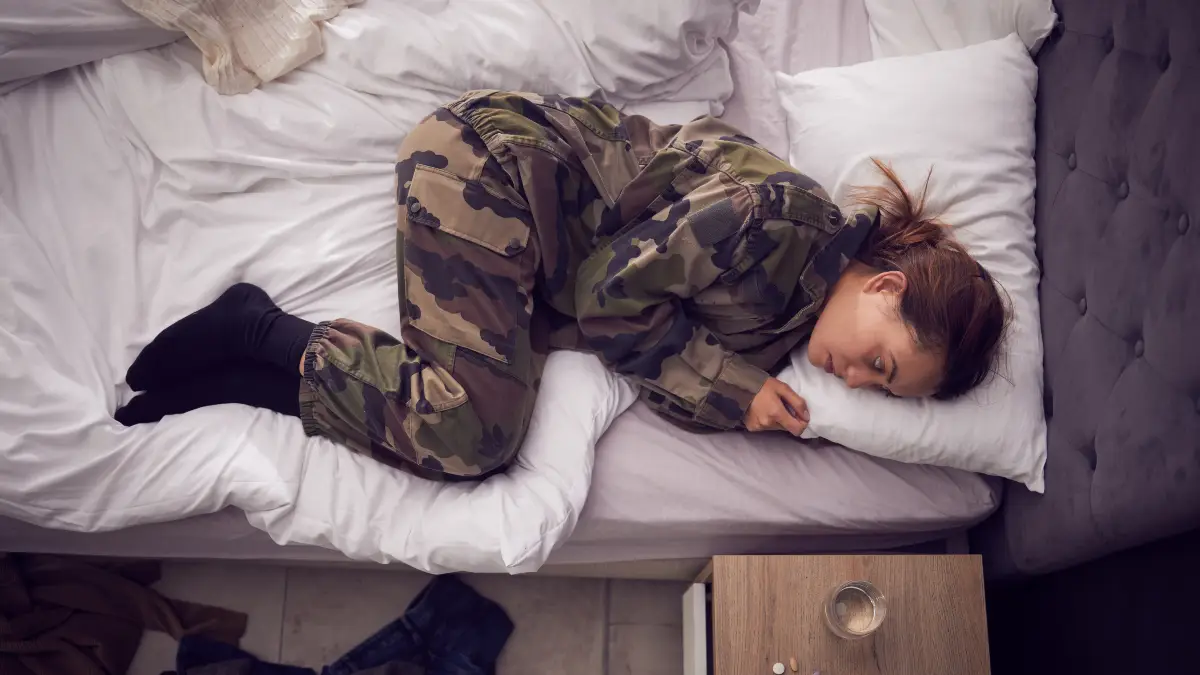The clock hits 2 a.m., and your mind is still running a marathon. You’ve probably seen the articles promising a secret military trick to fall asleep in just 120 seconds.
It sounds like the perfect fix for a world that’s forgotten how to rest, but for many, it feels more like a myth than a method. What if the real secret isn’t about hitting a two-minute deadline?
This guide cuts through the hype. We’ll break down the simple, science-backed steps that make this technique work—not as a magic trick, but as a practical tool to quiet your body, calm your racing thoughts, and finally reclaim your rest.
Why Is Everyone Talking About This Sleep Trick?

Why You Can’t Sleep (And Why You’re Not Alone)
You’ve probably seen it online. A secret military trick that promises to put you to sleep in just two minutes. It’s supposed to work anywhere, even on a noisy battlefield. For a world that feels like it’s always “on,” this sounds like the perfect fix for a huge problem.
Why is this idea so popular? Because so many of us just can’t get enough rest. In the United States, 50 to 70 million adults have some kind of sleep disorder. About one out of every three people don’t get the sleep they need on a regular basis.
Many of us have trouble sleeping sometimes, but for 10% to 15% of people, it’s a constant, daily struggle. This isn’t just a small problem. It’s a major health issue.
And it costs a lot. Not getting enough sleep costs the U.S. economy over $411 billion a year. People being too tired at work costs another $63.2 billion. But the cost to your health is even scarier.
If you don’t sleep enough for a long time, you have a higher risk for serious health problems. This includes things like obesity, dementia (your risk goes up by 33%), and heart disease (your risk goes up by 48%). It also makes you almost three times more likely to get type 2 diabetes.
The danger can be immediate, too. Driving while drowsy causes around 6,000 deadly car crashes in the U.S. every year. Being tired is also a big reason for the 100,000 deaths from medical mistakes in hospitals each year.
The fact that we’re all looking for a simple, two-minute fix shows how big this problem is. We want an easy “hack” to solve something that’s tied to the stress of our busy lives.
This article will break down the story of the military sleep method. More importantly, it will show you the real science behind it. This will give you a better, more honest way to get the rest you need.
Where Did This Military Sleep Method Come From?

This famous sleep trick didn’t start in a science lab. It came from the world of military pilots and top athletes. The person who created it was Lloyd “Bud” Winter, an Olympic sprint coach.
During World War II, he was given an important job: help pilots at the U.S. Navy Pre-Flight School perform better. In that high-stress place, being tired wasn’t just an issue; it was dangerous. A pilot who didn’t get enough sleep could make bad decisions, and in a war, that could be deadly.
Winter used the same ideas he used to train his athletes. He wrote about them in his 1981 book, Relax and Win: Championship Performance.
He believed that being tense, both in your body and your mind, was the enemy of good performance. A sprinter could run faster by relaxing certain muscles. In the same way, a pilot could think better by learning how to relax completely, whenever they needed to.
He taught the pilots how to let go of tension to save energy and stay ready for action.
This is where the legend comes from. According to Winter’s book, after practicing his relaxation steps for six weeks, 96% of the pilots could fall asleep in two minutes or less. And they could do it even in the worst conditions.
They could fall asleep sitting in a chair, after drinking coffee, and with the sound of fake machine guns playing in the background. This amazing story is why the method is still so popular today. But it’s important to remember where it came from.
It was a tool to help elite performers manage tiredness in a very stressful job, not a medical treatment for the sleep problems most of us face today.
How to Do the Military Sleep Method: A Step-by-Step Guide
The military sleep method is a simple, step-by-step process. It’s designed to take your body and mind from feeling awake and stressed to being calm and rested. Here is a guide on how to do it.
Step 1: Relax Your Body from Head to Toe (About 1 minute)
First, you need to get rid of the physical stress in your body. The goal is to let go of any tightness in your muscles, starting from your head and working your way down.
- Get into Position: Lie on your back in bed or sit in a chair. Your feet should be flat on the floor and your hands in your lap. Close your eyes.
- Relax Your Face: Your face holds a lot of tension. Start with your forehead. Smooth it out and let go of all the tightness. Let that relaxed feeling move down to your eyes, your cheeks, and your jaw. Let your mouth fall open a little. Relax your tongue and lips.
- Drop Your Shoulders and Arms: Let your shoulders drop as low as they can. Feel like you’re dropping a heavy weight. Now, focus on one arm at a time. Let your upper arm, forearm, and hand go completely limp. It should feel heavy. Do the same thing with your other arm.
- Relax Your Chest and Stomach: Take a slow, deep breath. As you breathe out, let your chest and stomach get soft. Let go of any tightness you’re holding there.
- Relax Your Legs: Now, think about your legs. Let your right thigh feel heavy and sink into the bed or chair. Let the feeling move down to your calf, ankle, and foot. Do the same thing with your left leg.
Step 2: Control Your Breathing (About 15 seconds)
You do this at the same time as you relax your body. It helps calm everything down.
- Breathe Deep and Slow: As you relax your muscles, keep breathing slowly and deeply. Breathe in through your nose and let your belly rise. Then, breathe out slowly through your mouth. Make your exhale a little longer than your inhale.9
Step 3: Clear Your Mind (The Last 10-30 seconds)
Your body is relaxed. Now it’s time to quiet your racing mind.
- Empty Your Mind for 10 Seconds: You need to stop thinking about your worries or your to-do list. Winter suggested two calm images to focus on :
- Image 1: Picture yourself lying in a canoe on a calm lake. Above you, there is only a clear blue sky. Just focus on how still everything is.
- Image 2: Imagine you are in a black velvet hammock. The room is completely dark. Focus on how comfortable and peaceful it feels.
- Block Other Thoughts: If your mind starts to wander, stop it by repeating the words “Don’t think, don’t think, don’t think” for 10 seconds. Then, go back to your calm image.
The main idea is simple. If you can keep your mind clear for just 10 seconds while your body is totally relaxed, you will fall asleep. This method isn’t just a few random tips. It’s a structured plan to shut down the three things that keep you awake: tense muscles, a high heart rate, and a busy mind.
Does This Stuff Actually Work? Here’s the Science

Why Relaxing Your Body Is the First Step to Sleep
The first part of the military method is a technique called Progressive Muscle Relaxation, or PMR. A doctor named Edmund Jacobson came up with it in the 1920s.
The idea is simple: your body can’t be relaxed and anxious at the same time. It’s one or the other.
There’s a lot of proof that PMR helps with sleep. The American Academy of Sleep Medicine says it’s a good way to treat long-term insomnia without using medicine. Studies show it also helps with anxiety, headaches, and even high blood pressure.
It works in two ways. First, it calms your body down by releasing muscle tightness. Second, it teaches you to notice when you’re getting tense. After you practice for a while, you can feel the tension starting and let it go before it gets bad.
This stops the cycle where stress makes your muscles tense, and tense muscles make you feel more stressed.
There is one small difference to know. The classic way to do PMR is to first tense a muscle for a few seconds, and then relax it. This helps you feel the difference between tense and relaxed.
The military method uses a simpler version, often called a “body scan.” You just focus on each muscle and let go of any tension you feel, without tensing it first. This makes sense if you’re trying to fall asleep.
Tensing your muscles right before bed might actually wake you up more. The military method’s body scan is a more direct way to get your body calm and ready for sleep.
How Your Breathing Controls Your Brain
The second part of the method is all about breathing. This is more than just taking a deep breath. It’s a way to flip a switch inside your body. Your body has two main modes. The first is “fight-or-flight,” which gets you ready for action.
The second is “rest-and-digest,” which helps you calm down and save energy. When you can’t sleep, you’re often stuck in fight-or-flight mode.
Slow, deep belly breathing is a great way to switch to rest-and-digest mode. When you breathe from your belly instead of your chest, you stimulate something called the vagus nerve. This nerve is like the main highway for your body’s relaxation system.
When you activate it, good things happen. Your heart rate slows down, your blood pressure drops, and your body makes less of the stress hormone cortisol.
Scientists at Stanford University found out exactly how this works. They found a small group of brain cells that connect your breathing to the parts of your brain that keep you awake and alert.
These cells watch how you’re breathing and send reports to your brain’s alert center. This means you can trick your brain into calming down just by breathing more slowly.
Breathing is the one part of this system you can control on purpose. It’s like a manual override switch to get your body ready for sleep.
How to Stop Your Mind from Racing at Night
After you’ve relaxed your body and slowed your breathing, there’s one last thing to deal with: your racing mind.
This is when you can’t stop thinking about your worries, your plans for tomorrow, or random thoughts that pop into your head. The military method uses pictures in your mind to fight this mental noise.
It works because your brain can’t focus on two things at once. If you make your brain focus on a calm, peaceful image, it doesn’t have the energy to worry about other things. You’re basically giving the anxious part of your brain a different job to do.
The two images Bud Winter suggested are very smart. They are not just random “happy places.” Both the “canoe on a calm lake” and the “black velvet hammock in a dark room” are designed to be as un-exciting as possible.
Winter knew that any thought of movement could keep you awake, so his images are completely still. There are no people in them, so you don’t have to think about conversations or relationships. And they are simple. One is just a blue sky, and the other is total darkness. They are designed to be boring in the best way possible.
The phrase “Don’t think, don’t think, don’t think” is for when your mind wanders anyway.
Trying not to think about something can sometimes make you think about it more. But in this case, the phrase is just a simple, repetitive task. It’s like counting sheep. It interrupts your stressful thoughts and gives your mind a chance to become calm again.
Can You Really Fall Asleep in 2 Minutes?

The different parts of the military sleep method are based on real science. Progressive relaxation, slow breathing, and visualization all work. But we need to talk about the biggest claim: falling asleep in two minutes.
First, let’s be clear. The “Military Sleep Method” as a whole has not been proven in any official scientific studies.
The 96% success rate story comes from Bud Winter’s book about sports, not from a medical trial. Most sleep experts agree that falling asleep in two minutes is not a realistic goal for most of us. For a healthy person, it normally takes 10 to 20 minutes to fall asleep.
Worrying about a two-minute deadline can actually make things worse. It can give you “performance anxiety” about sleep.
If two minutes pass and you’re still awake, you might get frustrated. That frustration causes stress, which makes it even harder to fall asleep. The so-called cure can become part of the problem.
It’s also important to remember who this was first designed for. The pilots in Winter’s program were extremely tired. Their bodies were desperate for sleep. For them, the relaxation trick just removed the last bit of stress that was keeping them awake.
But the average person with insomnia is different. You might feel “tired but wired.” Your mind is racing, but your body isn’t ready to crash. For you, the goal is to let sleep happen naturally, not to force it into a two-minute window.
The 2-minute claim is a great headline, but the real value is in learning how to relax, not in hitting a time limit.
Is This Method a Cure for Insomnia?
To know where this method fits, you have to look at how doctors treat sleep problems today. The best treatment for long-term insomnia is called Cognitive Behavioral Therapy for Insomnia, or CBT-I.
CBT-I is a full program that helps you change the thoughts and habits that are messing up your sleep. It includes a few key things :
- Changing Your Thoughts: Learning to challenge bad thoughts about sleep, like “If I don’t get 8 hours, tomorrow will be ruined.”
- Controlling Your Environment: Teaching your brain that your bed is for sleep. This means you only use your bed for sleep and sex. If you can’t sleep, you get up.
- Restricting Sleep: This sounds strange, but you limit your time in bed to only the hours you’re actually sleeping. This makes you more tired and helps you sleep more deeply.
- Relaxation Training: This is where you learn things like muscle relaxation and breathing exercises to calm down before bed.
When you look at it this way, you can see that the military sleep method is just a really good version of the “relaxation training” part of CBT-I.
It uses the same proven tools. But it doesn’t help with the negative thoughts or bad habits that often cause long-term sleep problems. It’s a great tool for calming down, but it’s not a complete cure for insomnia.
This table shows how the different methods compare.
| Feature | Military Sleep Method | Progressive Muscle Relaxation (PMR) | Cognitive Behavioral Therapy for Insomnia (CBT-I) |
| Main Goal | To relax quickly and fall asleep anywhere. | To reduce physical tension to calm your body and mind. | To fix the bad thoughts and habits that cause sleep problems. |
| What You Do | Simple muscle relaxation, deep breathing, and using mental images. | Tensing and then relaxing your muscles. | Changing thoughts, controlling your environment, limiting time in bed, and relaxation. |
| How Long It Takes | The story says 2 minutes after 6 weeks of practice. | You feel relaxed right away, but sleep benefits take time. | Usually 6-8 sessions for long-lasting results. |
| Scientific Proof | The parts are proven, but the whole method hasn’t been studied. | It has been studied a lot and is proven to work. | It is the #1 recommended treatment for long-term insomnia. |
Beyond the 2-Minute Myth: How to Use This Technique Effectively

To harness the true power of the military sleep method, one must first discard its most famous claim. The goal is not to win a race against the clock.
Instead, the objective should be to master a powerful relaxation ritual that consistently signals to the body and mind that the demands of the day are over and it is now safe to rest.
- Reframe the Goal: Abandon the two-minute target. The new goal is to successfully complete the full relaxation sequence each night, focusing on the process rather than the outcome.
- Consistency is Key: Like any skill, relaxation requires practice. The pilots in the original program practiced for six weeks to achieve proficiency. Commit to performing the routine every night as a non-negotiable part of your wind-down period.
- Practice in a Low-Stakes Environment: To build mastery without the pressure of needing to fall asleep, practice the full sequence during the day. A 10-minute break from work is an ideal opportunity to train your body and mind to respond to the relaxation cues.
- Cultivate a Passive Attitude: Trying too hard to relax is a paradox that creates tension. The proper mindset is one of “letting go” or “allowing,” not “forcing”. If your mind wanders, gently guide it back without judgment.
- Develop a Contingency Plan: If you complete the sequence and still find yourself wide awake after 20 minutes, do not lie in bed becoming frustrated. Get up, go to another room, and engage in a quiet, relaxing activity in dim light—such as reading a dull book—until you feel genuinely sleepy again.
Then, return to bed. This prevents the brain from forming a strong association between being in bed and feeling frustrated and awake.
Building Your Sleep Arsenal: The Importance of Sleep Hygiene
The military sleep method can be thought of as a specialized tool. For it to be effective, it needs to be deployed within a supportive overall strategy. That strategy is built on the foundation of good sleep hygiene—the habits and environmental factors that are conducive to quality sleep.
- Optimize Your Environment: Your bedroom should be a sanctuary for sleep. Keep it cool, dark, and quiet. This may involve using blackout curtains, a white noise machine, or earplugs.12
- Maintain a Consistent Schedule: Go to bed and wake up at roughly the same time every day, even on weekends. This helps to regulate your body’s internal clock, or circadian rhythm.
- Control Stimulant Intake: Avoid caffeine, nicotine, and alcohol in the hours leading up to bedtime. While alcohol may initially make you feel drowsy, it disrupts sleep architecture later in the night.
- Establish a Wind-Down Routine: In the 60-90 minutes before bed, engage in a relaxing pre-sleep ritual. This could include taking a warm bath, listening to calm music, or reading a physical book.
Crucially, this period should be screen-free, as the blue light emitted from phones, tablets, and computers can suppress the production of the sleep hormone melatonin.


